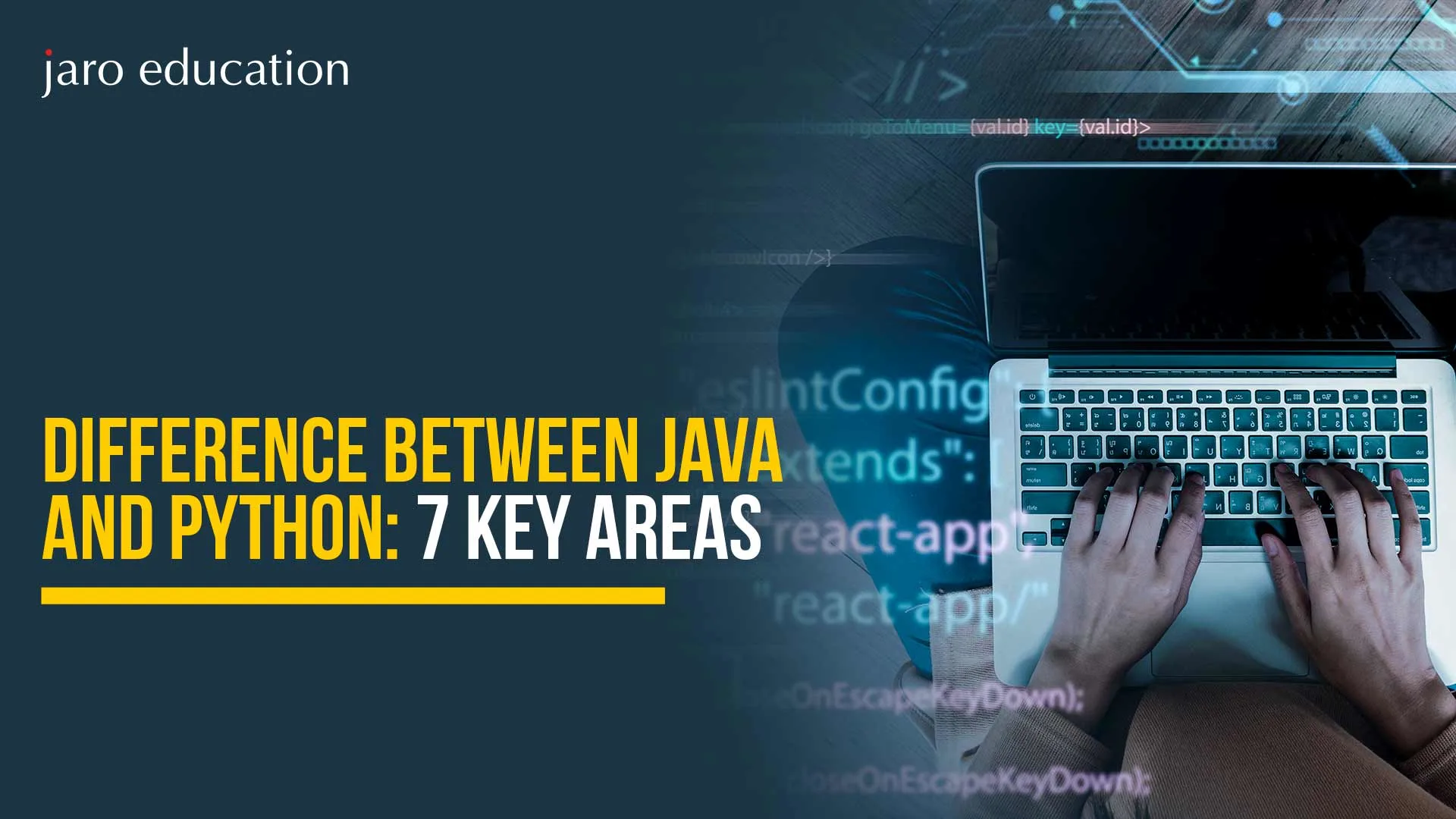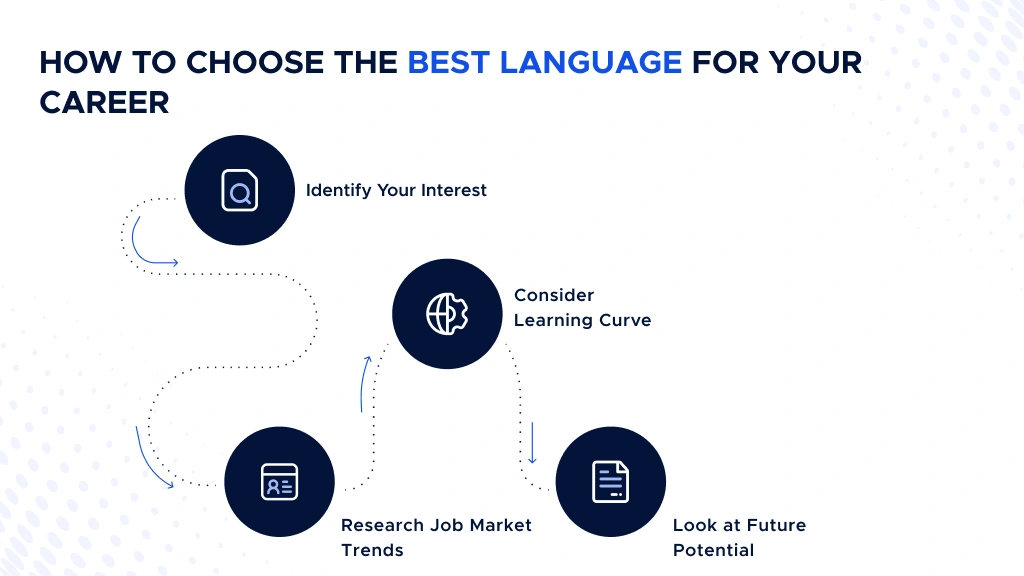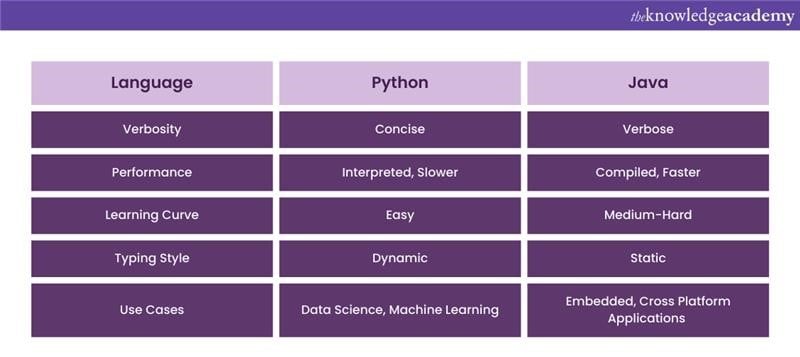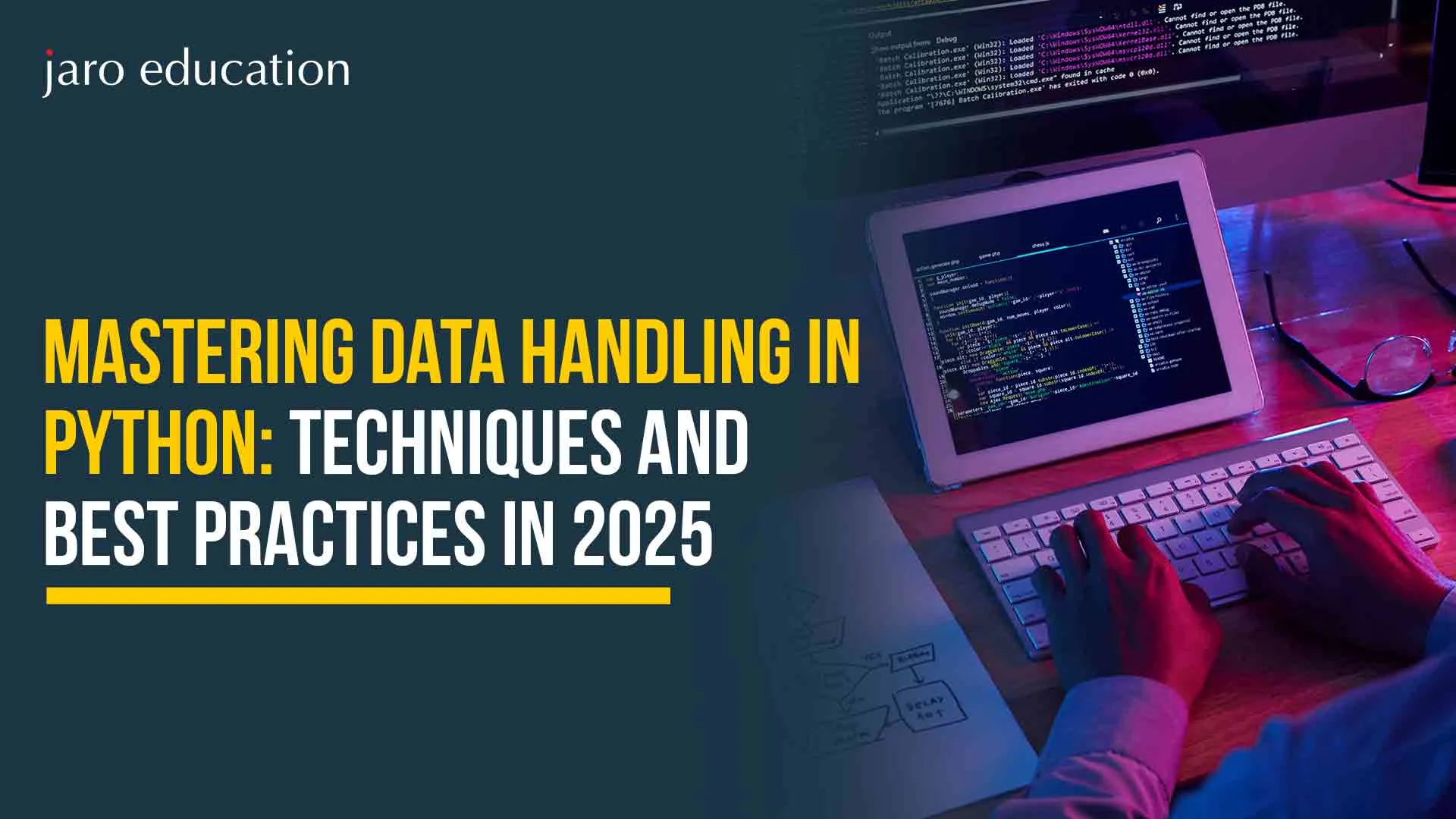Difference Between Java and Python: 7 Key Areas
Table of Contents

In today’s fast-evolving technology landscape, professionals often find themselves at a crossroads, wondering which programming language will best boost their career or help them pivot into emerging fields. If you’re considering upskilling or starting a journey into software development, a common question arises: What is the difference between Java and Python?
Both Java and Python are among the most popular programming languages worldwide, each offering unique advantages and opportunities. Understanding the difference between Java and Python is essential for making informed decisions about which language to learn, depending on your career goals, the industry you aim to work in, or the projects you want to build.
Choosing the Right Programming Language for Your Career

*digiscorp.com
Choosing between Java and Python is not simply about picking a popular programming language; it’s about making a strategic decision that can shape your entire career trajectory. Each language has distinct characteristics that influence not only how software is developed but also where and how it is applied across industries. As technology continues to advance rapidly, understanding these nuances becomes critical for professionals aiming to upskill, transition into new roles, or enter emerging fields such as artificial intelligence, data science, or enterprise software development.
Java has long been a cornerstone of large-scale enterprise applications, powering everything from banking systems to Android mobile apps. Python, on the other hand, has surged ahead as a go-to language for data scientists, Artificial intelligence researchers, and web developers due to its simplicity and versatility. However, beyond popularity, there are important differences in their syntax, performance, ecosystem, and learning curve that impact how quickly you can become proficient and how effectively you can apply the language in your chosen domain.
What Are The Differences Between Java and Python?

*theknowledgeacademy.com
By delving into the seven key areas that signify the difference between Java and Python, this blog aims to provide a clear, structured comparison. Whether you are a student deciding on your first programming language, a professional looking to switch careers, or an organization considering which language to adopt for a project, this guide will help you make an informed choice grounded in industry trends and practical realities.
With the rise of data science, web development, enterprise applications, and artificial intelligence, professionals today need clarity on the Python and Java differences to align their skill set with market demands. This blog dives into the difference between Java and Python across seven critical areas, helping you navigate the choice with confidence.
1. Syntax and Ease of Learning
One of the most immediate and noticeable differences between Java and Python is their syntax. This impacts how quickly beginners and even experienced developers can write and debug code.
| Feature | Java | Python |
|---|---|---|
| Syntax Complexity | Verbose and strictly typed | Simple, clean, and dynamically typed |
| Code Length | Requires more lines of code to perform tasks | Concise; performs the same tasks with fewer lines |
| Learning Curve | Steeper, especially for beginners | Gentler, considered beginner-friendly |
| Error Handling | Compile-time errors are often caught early | Errors are mostly detected at runtime |
Java enforces explicit type declarations and has a rigid structure, which can be overwhelming initially but helps avoid certain runtime errors. Meanwhile, Python’s simpler syntax and dynamic typing allow learners to write functional code quickly, making it ideal for beginners or rapid prototyping.
2. Performance and Speed
When choosing between Java and Python, understanding performance differences is crucial, especially for applications where speed matters.
| Aspect | Java | Python |
|---|---|---|
| Execution Type | Compiled to bytecode, runs on JVM | Interpreted language |
| Speed | Generally faster, closer to C++ | Slower due to interpretation |
| Memory Management | Automated via JVM garbage collection | Also uses garbage collection |
| Use in Performance-critical Apps | Common in enterprise backend and Android | Less suited for high-performance apps |
Java’s compilation to bytecode and execution on the JVM (Java Virtual Machine) often results in faster and more efficient runtime performance compared to Python’s interpreted nature. This makes Java the preferred choice for large-scale, performance-sensitive applications, while Python’s slower execution is often acceptable in prototyping, data analysis, or scripting scenarios.
3. Use Cases and Industry Applications
The difference between Java and Python also manifests strongly in where and how these languages are predominantly used.
| Industry/Application | Java | Python |
|---|---|---|
| Enterprise Applications | Widely used in banking, telecom, and retail | Used mainly for backend services |
| Mobile Development | Primary language for Android apps | Limited native mobile app support |
| Web Development | Frameworks like Spring, Java EE | Popular frameworks: Django, Flask |
| Data Science & AI | Limited compared to Python | Leading language for AI and ML |
| Game Development | Used with engines like jMonkeyEngine | Used in simpler 2D games, prototyping |
Java dominates in enterprise environments, Android mobile development, and large systems requiring stability and scalability. Conversely, Python leads in data science, machine learning, scripting, automation, and web development with rapid iteration cycles. Recognizing this Python and Java difference in use cases is vital when planning your career trajectory.
4. Community and Ecosystem
A robust ecosystem and active community are indispensable for developers. The choice between Java and Python can be influenced by the availability of libraries, frameworks, and community support.
| Aspect | Java | Python |
|---|---|---|
| Libraries & Frameworks | Extensive for enterprise, mobile, and web | Rich in data science, AI, and web |
| Community Size | Large, mature, corporate-backed | Rapidly growing, diverse, open-source focused |
| Documentation & Support | Strong documentation, long history | Extensive tutorials, active forums |
| Updates & Evolution | Regular updates with backward compatibility | Frequent updates and new features |
Both Java and Python have thriving communities; however, Python’s ecosystem is more geared toward emerging fields like AI and data analytics. Java’s ecosystem is battle-tested, powering critical systems globally. For learners, choosing between a language with a mature enterprise ecosystem or one with innovative research and development support can impact learning outcomes and job opportunities.
5. Career Opportunities and Salary Insights
Understanding what is the difference between Java and Python in terms of career prospects can help professionals target the right skill set for maximum impact.
| Role | Average Salary (INR) | Demand |
|---|---|---|
| Java Developer | ₹6 - ₹12 Lakhs per annum | High in enterprise, banking |
| Python Developer | ₹7 - ₹14 Lakhs per annum | High in AI, data science |
| Data Scientist (Python) | ₹8 - ₹18 Lakhs per annum | Rapidly growing |
| Android Developer (Java) | ₹5 - ₹10 Lakhs per annum | Consistent demand |
Source: AmbitionBox, geeksforgeeks
Both Java and Python offer lucrative career paths. Java developers often find roles in stable sectors like banking and telecom, while Python developers enjoy opportunities in innovative domains such as machine learning and analytics. The difference between Java and Python here also reflects evolving market trends, with Python rapidly increasing in demand due to AI and automation growth.
6. Development Environment and Tools
This is a significant difference between Java and Python, development experience, which impacts productivity and provides ease of debugging.
| Feature | Average Salary (INR) | Demand |
|---|---|---|
| IDEs & Editors | IntelliJ IDEA, Eclipse, NetBeans | PyCharm, Jupyter Notebook, VS Code |
| Debugging | Strong debugging tools, strict error checks | Simple debugging, interactive console |
| Build Tools | Maven, Gradle | Pip, virtual environments |
| Deployment | Complex, requires JVM setup | Easy, scripts can run on most systems |
Java’s robust IDE support and strict syntax offer comprehensive debugging, but can slow down rapid experimentation. Python’s flexible and interactive development style, especially through tools like Jupyter notebooks, makes it a favorite among data scientists and educators for quick iterations.
7. Learning Curve and Community Support for Beginners
Finally, the ease of entry and available learning resources heavily influence which language is better suited for those starting.
| Factor | Average Salary (INR) | Demand |
|---|---|---|
| Beginner Friendliness | Moderate to challenging | Highly beginner-friendly |
| Available Learning Resources | Extensive courses, official docs | Abundant tutorials, interactive platforms |
| Error Feedback | Compile-time errors help with debugging | Runtime errors sometimes confusing |
| Community Help | Large corporate-backed forums | Vibrant, supportive beginner communities |
While Java’s structure teaches strong programming discipline, Python’s straightforward syntax lowers the barrier to entry, making it ideal for students and professionals transitioning into programming for the first time. Choosing a Java and Python course also depends on personal learning preferences and long-term goals.
How Jaro Education Helps You Navigate the Java and Python Landscape
At Jaro Education, empowering professionals with the right skills is a priority. Whether you want to master Java, explore Python, or understand the difference between Java and Python to make an informed choice, Jaro offers curated programs designed for career growth.
Our Key Offerings:
- University Partnerships: Collaborations with reputed institutions offering specialized courses that also teach Java and Python programming.
- Flexible Learning: Online, live sessions that fit around your schedule.
- Expert Faculty: Industry veterans and academic experts guiding your journey.
- Program Highlights:
- Learning Format: Live interactive classes, recorded sessions, practical projects
- Ideal For: Aspiring software developers, IT professionals, data enthusiasts
- Learning Format: Live interactive classes, recorded sessions, practical projects
- Career Guidance: Personalized counseling to help you choose courses aligned with market trends and your aspirations.
- Value-Added Services: Access to Jaro Connect for networking, mentorship, and additional resources.
Note: For degree programs, Jaro serves as a service provider and counselor but is not the degree-granting authority. Certification courses are delivered in collaboration with top IITs, IIMs, and other prestigious institutes, with Jaro facilitating your learning experience.
Take Action Today:
- Start your learning journey today.
- Get personalized guidance from our experts.
- Explore exclusive programs with India’s top institutes.
Making an Informed Choice: Java or Python for Your Future
Choosing between Java and Python course is more than a technical decision—it’s a strategic step in your career. Understanding the difference between Java and Python across syntax, performance, industry applications, and learning curves ensures you invest in the right skill set for your future. As technology evolves, so do opportunities, and aligning your learning with these trends is key.
Jaro Education is here to guide you through this journey with expert counseling, flexible courses, and industry-relevant programs. With the right mix of education and training, the path to unlocking new professional opportunities becomes clearer and more achievable.
Frequently Asked Questions
What kind of support does Jaro provide during the course on the difference between Java and Python?
Jaro offers personalized counseling, live doubt-clearing sessions, access to expert faculty, and career guidance to help you master the difference between Java and Python effectively throughout your learning journey.
Can I apply if I am working full-time and want to learn the difference between Java and Python?
Yes. Jaro’s flexible learning formats, including live and recorded sessions, are designed to fit around your professional commitments, making it easy to study the difference between Java and Python alongside your job.
How is this program different from a regular online course?
Jaro partners exclusively with top universities and institutes, providing curated content, live interaction, and ongoing support rather than just pre-recorded materials.
Will this program help me transition into a new industry?
Yes. Our programs focus on industry-relevant skills and include career counseling to support smooth transitions into tech, data science, or software development roles.
Which language is better for beginners when considering the difference between Java and Python?
Python is generally considered more beginner-friendly due to its simple syntax and readability, making it easier to grasp programming fundamentals. Java offers strong typing and structure that build a solid foundation but may present a steeper learning curve for newcomers. Understanding the difference between Java and Python helps you choose based on your learning style and career goals.
How do the job markets compare when looking at the difference between Java and Python?
Both languages have strong demand, but Python’s popularity is growing rapidly in data science, AI, and automation. Java remains a staple in large enterprises, Android development, and banking sectors. Knowing the difference between Java and Python can help you align your skills with the right market opportunities.
















